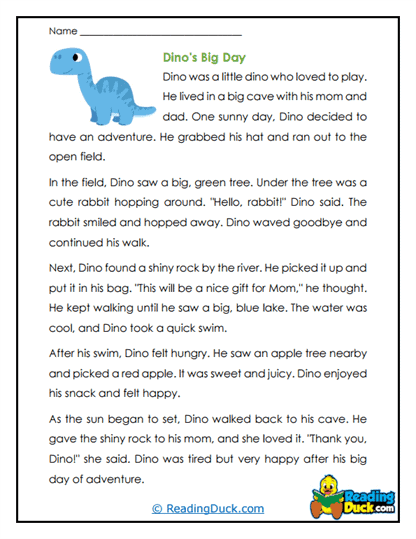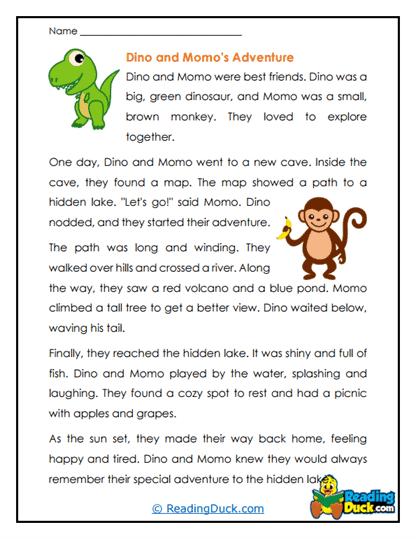CVCV Reading Passages Worksheets
About Our CVCV Reading Passages Worksheets
Our CVCV (Consonant-Vowel-Consonant-Vowel) Reading Passages Worksheets are designed to help students develop crucial phonics and reading skills by focusing on a fundamental word pattern. The CVCV pattern, where alternating consonants and vowels create words such as "mama," "baby," and "tiger," provides an excellent framework for early readers to practice blending sounds and decoding words. These worksheets offer students targeted reading passages that reinforce their understanding of CVCV word structures, helping them improve decoding skills, word recognition, and reading fluency.
Each worksheet in this collection is provided in a PDF format, ensuring easy access for educators and parents alike. These worksheets are simple to download, print, and use in various learning environments. Additionally, each worksheet comes with a downloadable answer key, offering educators and parents a quick way to check student progress and provide immediate feedback. This flexibility makes the CVCV Reading Passages Worksheets a highly effective tool for supporting students' phonics development at school or at home.
Features and Benefits of the CVCV Reading Passages Worksheets
The CVCV Reading Passages Worksheets offer numerous benefits for students as they work to build foundational reading skills. With a focus on the CVCV word structure, these worksheets provide repetitive and meaningful practice that enhances phonics comprehension. Below are the key features and benefits of this collection:
- Focused Phonics Practice: The worksheets concentrate on CVCV word patterns such as "papa," "lava," "baby," and "lolo," providing students with multiple exposures to these important phonics combinations.
- Improved Word Recognition: Repeatedly encountering CVCV words in context helps students improve their ability to recognize and decode these words, strengthening their overall word recognition skills.
- Enhanced Decoding Skills: The CVCV pattern helps students practice blending and segmenting sounds, which is vital for developing effective decoding strategies.
- Fluency Development: By practicing CVCV words in reading passages, students work on increasing both their reading speed and accuracy, contributing to overall fluency.
- Application in Context: The reading passages present CVCV words within meaningful contexts, allowing students to apply their phonics knowledge in real reading situations rather than isolated word drills.
These worksheets are ideal for helping students master the CVCV word pattern, a foundational step in early literacy.
Strategies for Using the Worksheets in Classroom Instruction
The CVCV Reading Passages Worksheets are versatile and can be easily integrated into various classroom settings to support daily reading and phonics instruction. Here are several strategies that teachers can use to incorporate these worksheets into their lessons:
- Group Reading Sessions: Use the passages for group reading exercises where students take turns reading aloud. This encourages students to practice decoding CVCV words and builds confidence in their reading abilities within a collaborative environment.
- Phonics Warm-Up Activity: Begin each phonics lesson with a short passage from the worksheets. This serves as an effective warm-up activity that gets students focused on the CVCV word structure for the day’s lesson.
- Independent Reading Practice: Assign the worksheets during independent reading time to provide students with an opportunity to apply their phonics skills on their own. This self-paced practice allows students to reinforce their understanding of CVCV words.
- Small Group Instruction: Use the worksheets in small group settings to provide additional support to students who may need more practice decoding CVCV words.
- Phonics Review: Integrate the passages as a review activity at the end of a phonics unit to help students solidify their understanding of CVCV patterns.
- Formative Assessment: The included answer keys make it easy for educators to assess student progress in decoding and reading fluency, ensuring that students are developing strong phonics skills.
These strategies can help teachers create engaging and effective lessons that reinforce the CVCV phonics pattern while promoting reading fluency and confidence.
Supporting Literacy Development at Home with CVCV Worksheets
Parents and caregivers can also use the CVCV Reading Passages Worksheets to support their child’s literacy development at home. These worksheets are an excellent way to provide extra phonics practice in a fun and structured way, helping to reinforce classroom learning. Here are some suggestions for using the worksheets effectively at home:
- Daily Reading Practice: Incorporate the worksheets into your child’s daily reading routine by assigning one passage to read aloud each evening. This helps reinforce their understanding of CVCV word patterns while improving fluency.
- Shared Reading: Take turns reading passages aloud with your child. This shared reading activity gives your child the opportunity to hear CVCV words read aloud, while also encouraging them to practice their own reading skills.
- Homework Supplement: Use the worksheets as a supplement to classroom homework, allowing your child to continue practicing phonics skills at home. After completing a passage, review the answers together using the answer key to provide immediate feedback.
- Fluency Building Through Repetition: Encourage your child to read the same passage multiple times. Repeated reading helps improve both reading speed and accuracy, leading to greater fluency with CVCV word patterns.
- Tracking Progress: Monitor your child’s progress by noting improvements in word recognition, decoding, and reading fluency. Offer praise and rewards to motivate continued practice and build confidence.
By regularly practicing with these worksheets, parents can help their children strengthen their phonics skills and enhance their overall reading ability.
The Importance of Mastering CVCV Word Patterns
CVCV word patterns are foundational for early phonics instruction. Understanding these patterns provides young readers with critical tools for decoding words and blending sounds. Mastering the CVCV pattern is important for several reasons:
- Strengthening Sound Blending: CVCV words like “mama,” “baby,” and “taco” give students the opportunity to practice blending consonant and vowel sounds, which is essential for decoding longer, more complex words.
- Building Early Vocabulary: Learning CVCV words helps expand students’ vocabulary, giving them access to a greater variety of words they will encounter in early reading materials.
- Foundation for Future Phonics Concepts: Mastering CVCV word patterns prepares students to decode more complex word structures, such as multisyllabic words or words with consonant blends.
- Developing Confidence in Reading: Understanding and recognizing CVCV words gives students a sense of accomplishment, building their confidence as they progress toward more advanced reading tasks.
The CVCV Reading Passages Worksheets provide students with a structured and supportive way to master these important phonics concepts, leading to improved reading skills.
Building Fluency with Regular Practice
Reading fluency is a crucial part of early literacy development, and the CVCV Reading Passages Worksheets are designed to promote fluency by giving students regular, focused practice with decoding and reading CVCV words. Fluency involves reading text accurately, quickly, and with the proper expression, all of which contribute to better comprehension. Here’s how the worksheets help students build fluency:
- Improving Accuracy: As students become more familiar with CVCV words through repeated practice, they improve their accuracy in decoding these words.
- Increasing Reading Speed: Fluency requires both speed and smoothness in reading. The passages provide students with consistent opportunities to practice reading CVCV words in context, helping them read more quickly over time.
- Enhancing Comprehension: When students become fluent readers, they can focus more on understanding the meaning of the text rather than getting stuck on individual words. The CVCV Reading Passages Worksheets promote fluency while supporting comprehension.
With regular use, these worksheets help students become more fluent readers, enabling them to read with greater confidence and understanding.
Tips for Maximizing the Effectiveness of the Worksheets
To get the most out of the CVCV Reading Passages Worksheets, both educators and parents can follow these practical tips:
- Set Clear Learning Goals: Before starting each worksheet, establish specific learning goals for your students or child, such as improving decoding or increasing reading speed with CVCV words.
- Encourage Repeated Reading: Repetition is key to mastering phonics patterns. Have students or your child read the passage multiple times to reinforce the CVCV word pattern and build fluency.
- Integrate into Homework Assignments: Use the worksheets as part of weekly homework to ensure that students are practicing their phonics skills consistently.
- Monitor Progress and Provide Feedback: Use the answer keys to track student performance and offer timely feedback, celebrating progress in decoding and fluency.
- Use in Literacy Centers: Incorporate the worksheets into literacy centers in the classroom, where students can practice independently or with peers.
By following these tips, educators and parents can help students make the most of their practice with CVCV word patterns, ensuring steady progress in phonics and reading fluency.
Conclusion
The CVCV Reading Passages Worksheets are a valuable resource for developing early phonics and reading skills. With a focus on the CVCV word pattern, these worksheets provide targeted practice that helps students improve decoding, word recognition, and reading fluency. Available in a PDF format and complete with answer keys, these worksheets are versatile tools for both classroom instruction and home practice.
Through consistent use of these worksheets, students will gain confidence in their reading abilities and build the foundational phonics skills needed for long-term literacy success.









